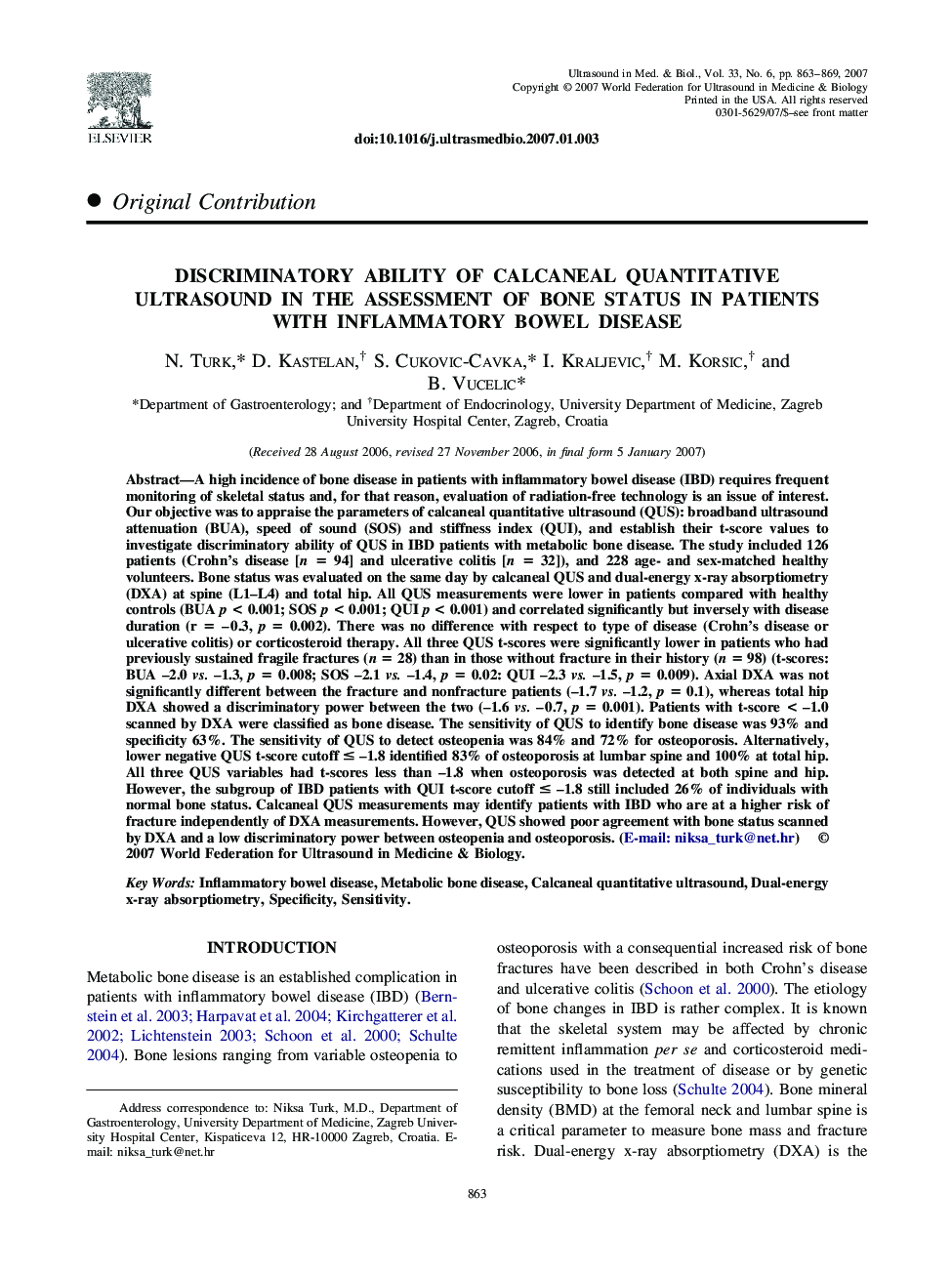| کد مقاله | کد نشریه | سال انتشار | مقاله انگلیسی | نسخه تمام متن |
|---|---|---|---|---|
| 1762964 | 1019731 | 2007 | 7 صفحه PDF | دانلود رایگان |
عنوان انگلیسی مقاله ISI
Discriminatory Ability of Calcaneal Quantitative Ultrasound in the Assessment of Bone Status in Patients With Inflammatory Bowel Disease
دانلود مقاله + سفارش ترجمه
دانلود مقاله ISI انگلیسی
رایگان برای ایرانیان
کلمات کلیدی
موضوعات مرتبط
مهندسی و علوم پایه
فیزیک و نجوم
آکوستیک و فرا صوت
پیش نمایش صفحه اول مقاله

چکیده انگلیسی
A high incidence of bone disease in patients with inflammatory bowel disease (IBD) requires frequent monitoring of skeletal status and, for that reason, evaluation of radiation-free technology is an issue of interest. Our objective was to appraise the parameters of calcaneal quantitative ultrasound (QUS): broadband ultrasound attenuation (BUA), speed of sound (SOS) and stiffness index (QUI), and establish their t-score values to investigate discriminatory ability of QUS in IBD patients with metabolic bone disease. The study included 126 patients (Crohn's disease [n = 94] and ulcerative colitis [n = 32]), and 228 age- and sex-matched healthy volunteers. Bone status was evaluated on the same day by calcaneal QUS and dual-energy x-ray absorptiometry (DXA) at spine (L1-L4) and total hip. All QUS measurements were lower in patients compared with healthy controls (BUA p < 0.001; SOS p < 0.001; QUI p < 0.001) and correlated significantly but inversely with disease duration (r = -0.3, p = 0.002). There was no difference with respect to type of disease (Crohn's disease or ulcerative colitis) or corticosteroid therapy. All three QUS t-scores were significantly lower in patients who had previously sustained fragile fractures (n = 28) than in those without fracture in their history (n = 98) (t-scores: BUA -2.0 vs. -1.3, p = 0.008; SOS -2.1 vs. -1.4, p = 0.02: QUI -2.3 vs. -1.5, p = 0.009). Axial DXA was not significantly different between the fracture and nonfracture patients (-1.7 vs. -1.2, p = 0.1), whereas total hip DXA showed a discriminatory power between the two (-1.6 vs. -0.7, p = 0.001). Patients with t-score < -1.0 scanned by DXA were classified as bone disease. The sensitivity of QUS to identify bone disease was 93% and specificity 63%. The sensitivity of QUS to detect osteopenia was 84% and 72% for osteoporosis. Alternatively, lower negative QUS t-score cutoff ⤠-1.8 identified 83% of osteoporosis at lumbar spine and 100% at total hip. All three QUS variables had t-scores less than -1.8 when osteoporosis was detected at both spine and hip. However, the subgroup of IBD patients with QUI t-score cutoff ⤠-1.8 still included 26% of individuals with normal bone status. Calcaneal QUS measurements may identify patients with IBD who are at a higher risk of fracture independently of DXA measurements. However, QUS showed poor agreement with bone status scanned by DXA and a low discriminatory power between osteopenia and osteoporosis. (E-mail: niksa_turk@net.hr)
ناشر
Database: Elsevier - ScienceDirect (ساینس دایرکت)
Journal: Ultrasound in Medicine & Biology - Volume 33, Issue 6, June 2007, Pages 863-869
Journal: Ultrasound in Medicine & Biology - Volume 33, Issue 6, June 2007, Pages 863-869
نویسندگان
N. Turk, D. Kastelan, S. Cukovic-Cavka, I. Kraljevic, M. Korsic, B. Vucelic,